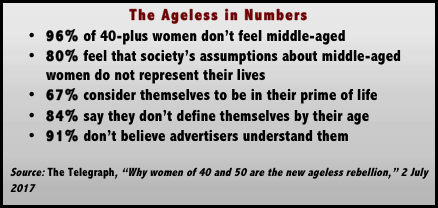Why are most consumer marketers still segmenting by generation and focusing nearly all of their resources at the 18 to 34 year-old demographic? I am not aware of a solid answer for this phenomenon, except that these marketers are simply not as savvy as they ought to be on the potential of the older consumer.
The fact is that despite Millennials now being the largest generation (yes, larger than Baby Boomers), it’s theGen Xers (those born between 1965 and 1980) who spend the most money, according to the U.S. Bureau of Labor Statistics (BLS). Yes, Xers spend more on housing, clothing, dining out, entertainment, and food at home—to the tune of nearly $67,000 per year. The next cohort of big spenders is—you guessed it—Baby Boomers (at $59,646). This BLS video explains in more detail how Millennials spend compared with other generations.

A recent article in The Telegraph examines how middle-aged women today are still saddled by stereotypes that have them wearing frumpy dresses, elasticized jeans, and “old-lady” comfort shoes, despite evidence to the contrary. According to a survey of women conducted by the British newspaper, 84 percent of respondents used “products and services they felt were aimed at younger women.” What’s more, 90 percent consider themselves to have a much younger attitude than their own mother’s generation at the same age.
And yet, marketers continue to zero in on Millennials “despite the greater financial firepower of 40-plussers,” the article notes. “We know that 85 percent of purchasing decisions are made by women and yet 91 percent of women don’t believe advertisers understand them. This isn’t good enough,” Rebecca Rhodes, cofounder of marketing agency SuperHuman, told the The Telegraph.
Gina Pell, a self-described “early internet entrepreneur who built a cult brand” (according to her LinkedIn page), recently coined the term “perennial” to explain why marketers should stop targeting and stereotyping people based on their age: “we are ever-blooming, relevant people of all ages who live in the present time, know what’s happening in the world, stay current with technology, and have friends of all ages,” she said in her blog post. 
There are several takeaways here for anyone selling, providing, or promoting services or products in this space. If you aren’t considering Baby Boomers and Gen Xers, you may want to rethink your strategy. If you’re already targeting these consumers, get to know them better! To begin with, none of the generations are made up of homogenous people. This may make it trickier to know what they want, but one thing is for sure, “middle-aged” women don’t want to be pigeonholed into ageist stereotypes (this previous post contains more details and insights about the generations and the longevity economy).
Whatever the product, solution, or service you offer, Quantum Age Collaborative is here to help you create innovative and unique solutions that tap into the longevity economy to meet consumer demands in new and relevant ways.
If you want candid feedback from experts in the senior living field, contact Quantum Age today.